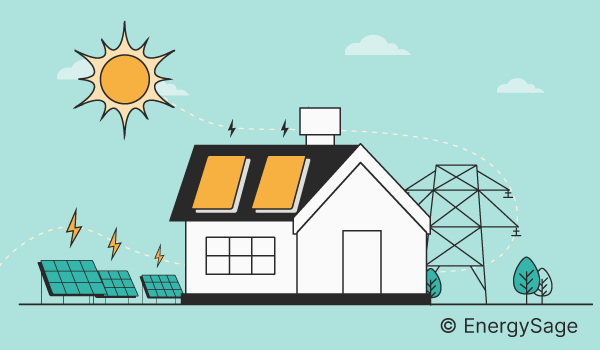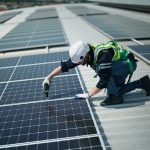A common way to take advantage of solar energy is with a photovoltaic (PV) solar system. With a solar PV system, your solar panels (also called solar modules) convert sunlight into electricity that you can use immediately, store in a solar battery, or send to the electric grid for credits on your electric bill through net metering (depending on where you live).
How do solar panels work?
Solar panels convert solar energy into usable electricity through a process known as the photovoltaic effect. The photovoltaic effect is a property of specific materials called semiconductors (nonmetals with conductive properties) that enables them to create an electric current when exposed to sunlight.
Solar panels consist of a layer of silicon cells, a metal frame, a glass casing unit, and wiring to transfer electric current from the silicon. Silicon is a semiconductor: When incoming sunlight strikes the silicon solar cells, it knocks electrons loose, setting them in motion and creating a flow of electric current. Wires then capture this direct current (DC) electricity and feed it to a solar inverter, which converts it to alternating current (AC) electricity, the type of electricity used by most of the U.S. electric grid and household appliances.
Types of photovoltaic energy systems
Solar panels are installed at three main scales: residential, commercial, and utility. As a homeowner, you can take advantage of residential-scale solar, typically in the form of rooftop solar or ground-mounted solar installed on open land. Generally, residential solar panel systems are between 5 and 20 kilowatts (kW), depending on the size of your home.
Commercial solar energy projects are typically installed at a greater scale than residential solar. While individual installations can vary greatly in size and cost, commercial-scale solar arrays serve a consistent purpose: They provide on-site solar power to businesses and nonprofits.
Finally, utility-scale solar projects are typically large-scale solar power plants that are several megawatts (MW) in size. Utility-scale solar installations provide solar energy to a large number of utility customers and may lower electricity costs in the future, but don’t currently provide any direct bill savings.
If you can’t install solar on your home or business, you can still save with community solar. Developers typically build community solar farms in central locations so they can provide power to multiple properties. As a subscriber, you’ll support the development of clean energy in your community and save between 5-20% on annual electricity costs.
This post was originally published on 3rd party site mentioned in the title of this site





